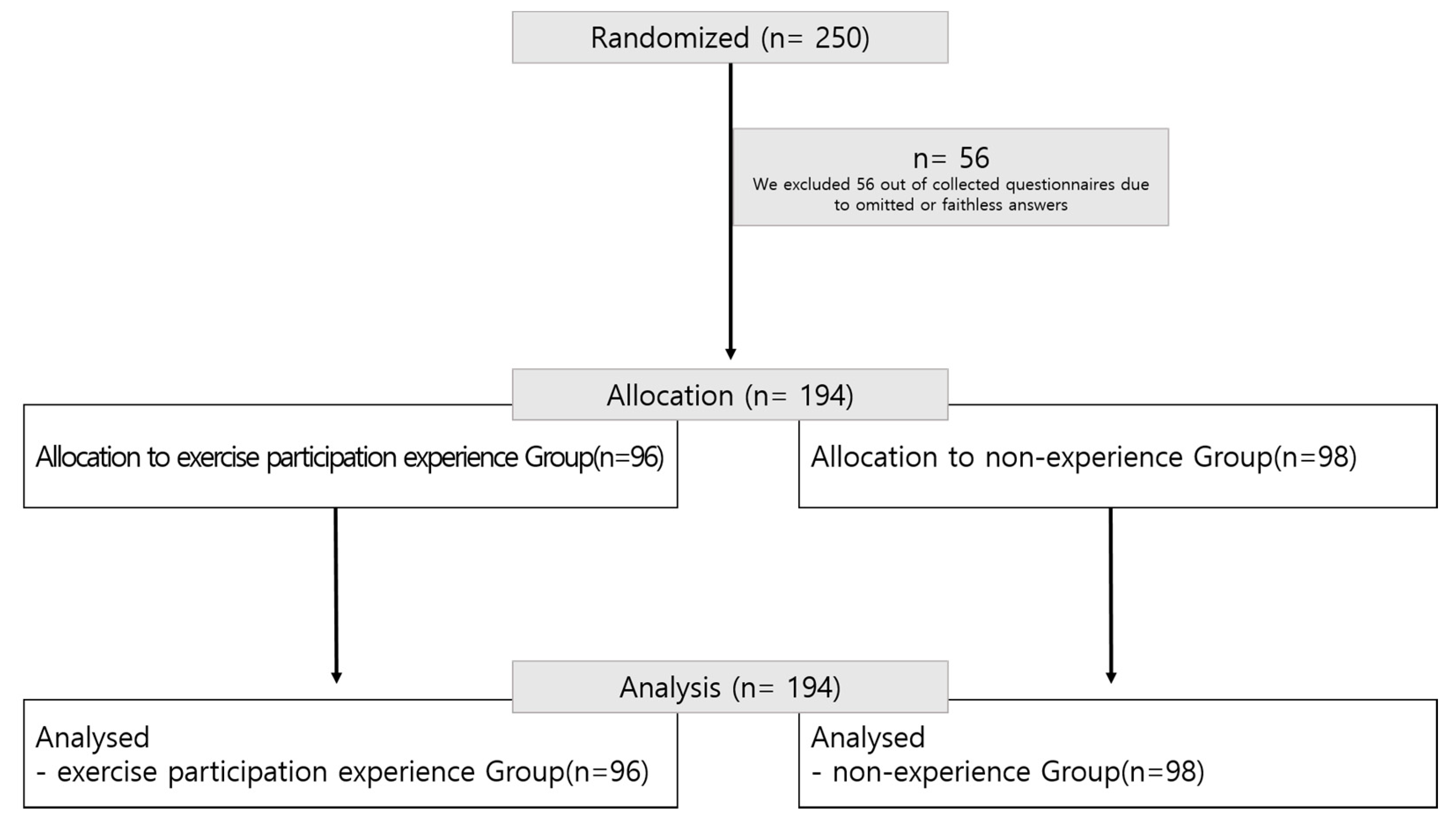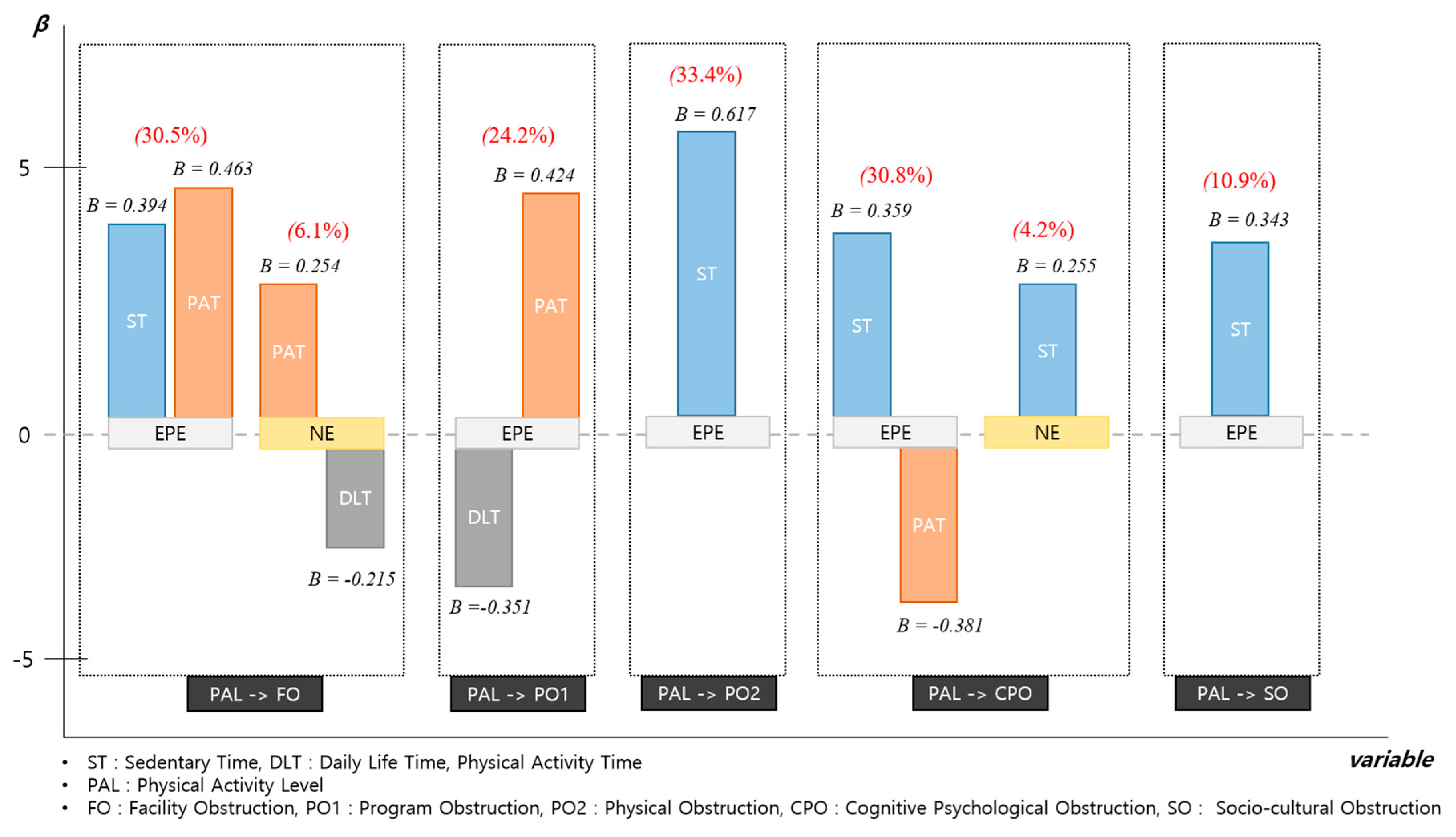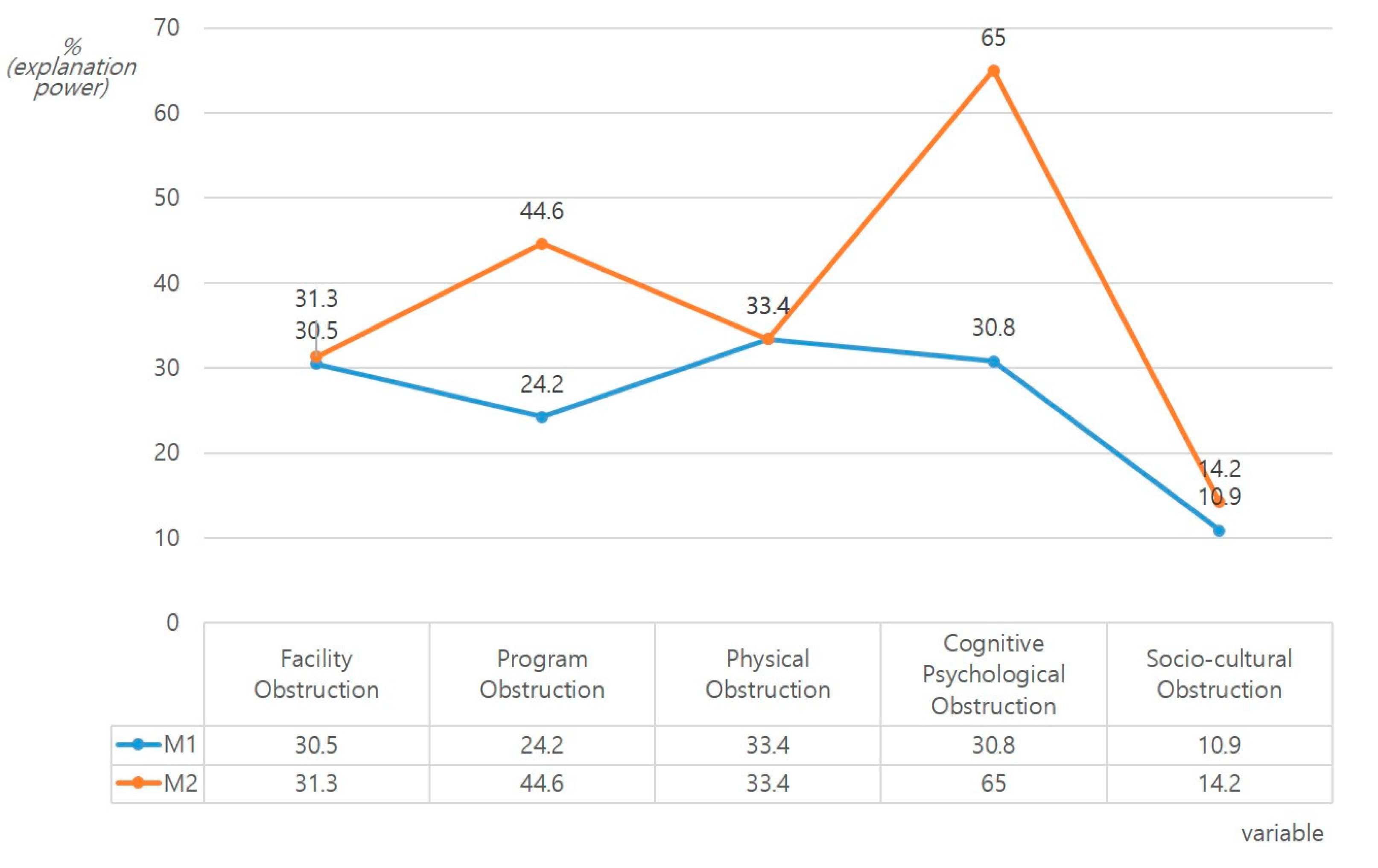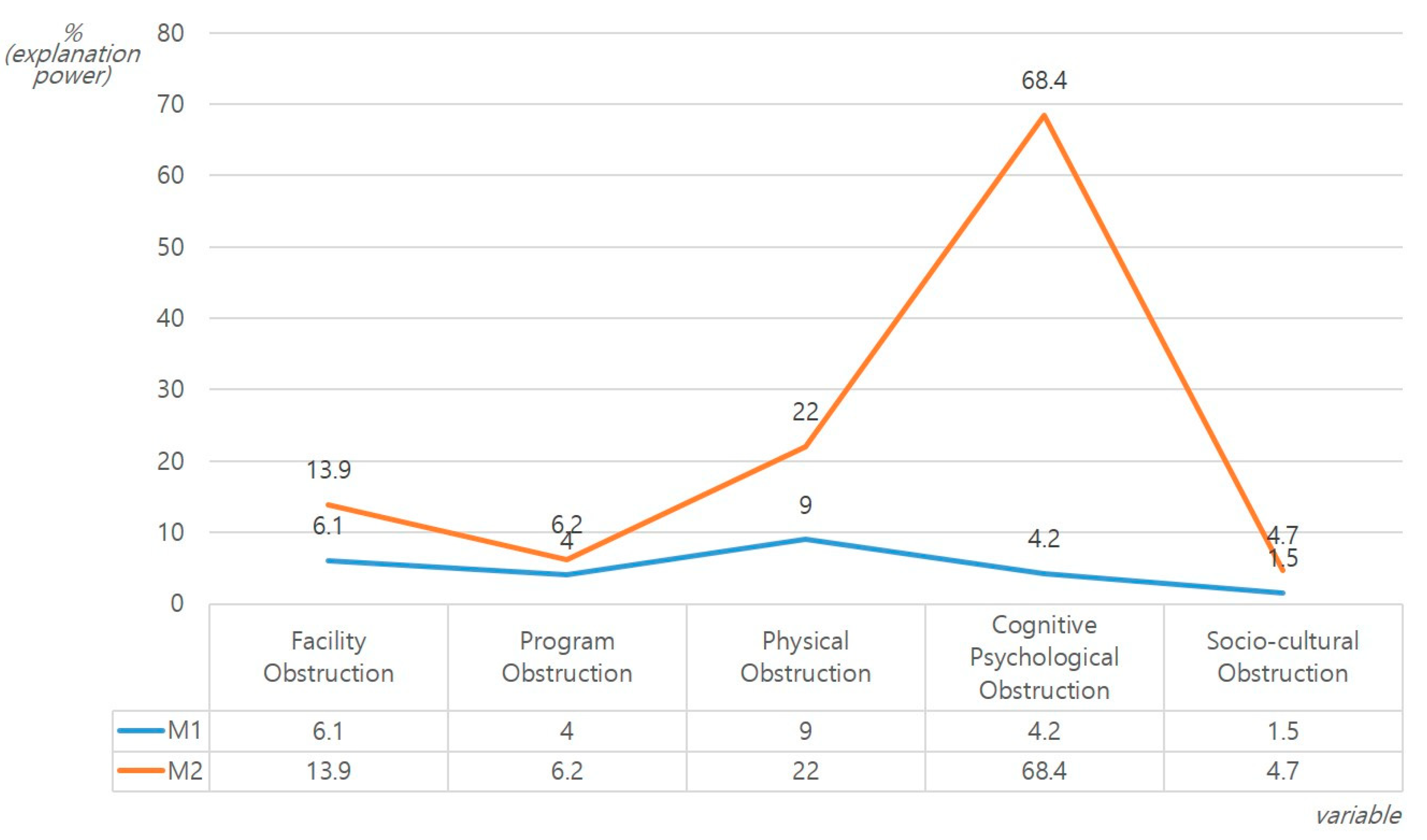Obstructions and the Recognition of Cancer Inpatient Physical Activity Based on Exercise Experience
Abstract
:1. Introduction
2. Methods
2.1. Subjects
2.2. Research Tools
2.3. Reliability and Validity of the Questionnaire
2.4. Data Analysis
3. Results
4. Discussion
5. Conclusions
Author Contributions
Funding
Conflicts of Interest
References
- Torre, L.A.; Bray, F.; Siegel, R.L.; Ferlay, J.; Lortet-Tieulent, J.; Jemal, A. Global cancer statistics, 2012. CA Cancer J. Clin. 2015, 65, 87–108. [Google Scholar] [CrossRef] [PubMed] [Green Version]
- Korea National Statistical Office. Cause of Death in Korea; Korea National Statistical Office: Daejeon, Korea, 2016.
- Ryan, R.M.; Deci, E.L. Self-Determination Theory: Basic Psychological Needs in Motivation, Development and Wellness; The Guilford Press: Guildford, UK, 2017. [Google Scholar]
- Reinboth, M.; Duda, J.L.; Ntoumanis, N. Dimensions of coaching behavior, need satisfaction, and the psychological and physical welfare of young athletes. Motiv. Emot. 2004, 8, 297–313. [Google Scholar] [CrossRef] [Green Version]
- Ntoumanis, N.; Quested, E.; Reeve, J.; Cheon, S.H. Need supportive communication: Implication for motivation in sport, exercise, and physical activity. In Persuasion and Communication in Sport, Exercise, and Physical Activity; Routledge: Abingdon, UK, 2017; pp. 155–169. [Google Scholar]
- Jackson, E.M.; Howton, A. Increasing walking in college students using a pedometer intervention: Differences according to body mass index. J. Am. Coll. Health 2008, 57, 159–164. [Google Scholar] [CrossRef] [PubMed]
- O’Donnel, M.P. Development and testing of the model of health promotion behavior in predicting exercise behavior. Korean J. Health Educ. Promot. 2000, 2, 31–61. [Google Scholar]
- Biddle, S.; Mutrie, N.; Gorely, T. Psychology of Physical Activity: Determinants, Well-Being and Interventions, 3rd ed.; Routledge: Abingdon, UK, 2015. [Google Scholar]
- Roland, N.J.; Rogers, S.N. Exercise interventions on health-related quality of life for cancer survivors. Clin. Otolaryngol. 2012, 37, 393–394. [Google Scholar] [CrossRef] [PubMed]
- Schmidt, R.A.; Lee, T.D. Motor Control and Learning: A Behavioral Emphasis; Human Kinetics: Champion, IL, USA, 2005. [Google Scholar]
- Spiegler, M.D.; Guevremont, D.C. Contemporary Behavior Therapy, 5th ed.; Thomson Wadsworth Publisher: Belmont, CA, USA, 2010; p. 609. [Google Scholar]
- Hirch, C.H.; Sommers, L. The natural history of functional mobility in hospitalizes older patients. J. Am. Geriatr. Soc. 1990, 38, 1296–1303. [Google Scholar] [CrossRef]
- Yang, E.J.; Chung, S.H.; Jeon, J.Y.; Seo, K.S.; Shin, H.I.; Hwang, J.H.; Lim, J.Y. current practice and barriers in cancer rehabilitation: Perspectives of Korean physiatrists. Cancer Res. Treat. 2015, 47, 370–378. [Google Scholar] [CrossRef]
- Campbell, A.; Mutri, N.; Whit, F.M.; McGuire, F.; Keamey, N. A pilot study of a supervised group exercise programme as a rehabilitation treatment for women with breast cancer receiving adjuvant treatment. Eur. J. Oncol. Nurs. 2005, 9, 56–63. [Google Scholar] [CrossRef]
- Schmidt, M.E.; Wiskemann, J.; Armbrust, P.; Schneeweiss, A.; Ulrich, C.M.; Steindorf, K. Effects of resistance exercise on fatigue and quality of life in breast cancer patients undergoing adjuvant chemotherapy: A randomized controlled trial. Int. J. Cancer 2015, 137, 471–480. [Google Scholar] [CrossRef]
- Oechsle, K.; Aslan, Z.; Suesse, Y.; Jensen, W.; Bokemeyer, C.; de Wit, M. Multimodal exercise training during myeloablative chemotherapy: A prospective randomized pilot trial. Support. Care Cancer 2014, 22, 63–69. [Google Scholar] [CrossRef]
- Aizen, I. Construction of a Standard Questionnaire for the Theory of Planned Behavior. Available online: http://www-unix.oit.umass.edu/~ajzen (accessed on 14 June 2020).
- Kim, Y.H. Integration of the theory of planned behavior with processes and stages of change to explaining exercise behavior change. Psychol. Sport Exerc. 2005, 16, 205–221. [Google Scholar]
- Nigg, C.R.; Rossi, J.S.; Norman, G.J.; Benisovich, S.V. Structure of decisional balance for exercise adoption. Ann. Behav. Med. 1998, 20, S211. [Google Scholar]
- Kang, S.J.; Par, J.H. The Transtheoretical model of exercise behavior change: Applications to decisional balance and stages of exercise change. Korean J. Meas. Evalution Phys. Edu. Sport Sci. 2001, 3, 1–12. [Google Scholar]
- Zhu, W.; Timm, G.; Ainsworth, B. Rasch calibration and optimal categorization of an instrument measuring women’s exercise perseverance and barriers. Res. Q. Exerc. Sport 2001, 72, 104–116. [Google Scholar] [CrossRef]
- Jo, J.H.; Song, G.J. Rasch calibration and evaluation of perceived barriers to exercise among college women. Korean J. Meas. Eval. Phys. Educ. Sport Sci. 2002, 4, 1–13. [Google Scholar]
- Alan, D. Psychosocially supportive design—Scandinavian health care design. World Hosp. Health Serv. 2001, 37, 20–24. [Google Scholar]
- Andrea, L.; Sarah, B.; Fatimah, H.; Karen, M.; Anita, O. The impact of exercise during adjuvant radiotherapy for breast cancer on fatigue and quality of life: A systematic review and meta-analysis. Breast 2017, 32, 144–155. [Google Scholar]
- Kim, J.Y.; Yi, E.S. Nationwide survey of cancer center programs in Korea. J. Exerc. Rehabil. 2017, 13, 300–306. [Google Scholar] [CrossRef]
- Shiraz, I.; Roberta, W.; Claire, S.; Paula, M.; Debra, R.; Ozlem, T. Exercise interventions on health-related quality of life for people with cancer during active treatment. Cochrane Database Syst. Rev. 2012, 15. [Google Scholar] [CrossRef]
- Lin, K.Y.; Shun, S.C.; Lai, Y.H.; Liang, J.T.; Tsauo, J.Y. Comparison of the effects of a supervised exercise program and usual care in patients with colorectal cancer undergoing chemotherapy. Cancer Nurs. 2014, 37, E21–E29. [Google Scholar] [CrossRef]
- Hardcastle, S.; Kane, R.; Chivers, P.; Hince, D.; Dean, A.; Higgs, D.; Cohen, P. Knowledge, attitudes, and practice of oncologists and oncology health care providers in promoting physical activity to cancer survivors: An international survey. Support. Care Cancer 2018, 26, 3711–3719. [Google Scholar] [CrossRef] [PubMed] [Green Version]
- Segal, R.; Evans, W.; Johnson, D.; Smith, J.; Colletta, S.; Gayton, J.; Woodard, S.; Wells, G.; Reid, R. Structured exercise improves physical functioning in women with stages I and II breast cancer: Results of a randomized controlled trial. J. Clin. Oncol. 2001, 19, 657–665. [Google Scholar] [CrossRef] [PubMed]
- Liou, Y.M.; Lee, H.L.; Chien, L.Y.; Kao, W.Y.; Chiang, C.C.; Wang, D.Y. Daily-life physical activity and related factors among patients with cancer receiving chemotherapy in Taiwan. Cancer Nurs. 2011, 34, 443–452. [Google Scholar] [CrossRef] [PubMed]
- May, A.; Bosch, M.; Velthuis, M.; van der Wall, E.; Steins Bisschop, C.; Los, M.; Erdkamp, F.; Bloemendal, H.; de Roos, M.; Verhaar, M.; et al. Cost-effectiveness analysis of an 18-week exercise programme for patients with breast and colon cancer undergoing adjuvant chemotherapy: The randomized PACT study. BMJ Open 2017, 7, e012187. [Google Scholar] [CrossRef] [PubMed] [Green Version]
- Gal, R.; Monninkhof, E.; Groenwold, R.; van Gils, C.; van den Bongard, D.; Peeters, P.; Verkooijen, H.; May, A. The effects of exercise on the quality of life of patients with breast cancer (the UMBRELLA Fit study): Study protocol for a randomized controlled trial. Trials 2017, 27, 504. [Google Scholar] [CrossRef]
- Kirshbaum, M.N. A review of the benefits of whole-body exercise during and after treatment for breast cancer. J. Clin. Nurs. 2007, 16, 104–121. [Google Scholar] [CrossRef]
- Bowers, L.; Boyle, D.A. Depression in patients with advanced cancer. Clin. J. Oncol. Nurs. 2003, 7, 281–288. [Google Scholar] [CrossRef] [Green Version]
- MacVicar, M.G.; Winningham, M.L.; Nickel, J.L. Effects of aerobic interval training on cancer patients’ functional capacity. Nurs Res. 1989, 38, 348–351. [Google Scholar] [CrossRef]
- Lucía, A.; Earnest, C.; Pérez, M. Cancer-related fatigue: Can exercise physiology assist oncologists? Lancet Oncol. 2003, 4, 616–625. [Google Scholar] [CrossRef]
- Schwartz, A.L. Exercise and weight gain in breast cancer patients receiving chemotherapy. Cancer Pract. 2000, 8, 231–237. [Google Scholar] [CrossRef]




| Independent Variable | Dependent Variable | EPE Group | NE Group | ||||
|---|---|---|---|---|---|---|---|
| Β | T | p | Β | T | p | ||
| Sedentary time | facility obstruction | 0.394 | 4.076 | 0.000 | −0.005 | −0.057 | 0.954 |
| Daily life time | −0.080 | −0.821 | 0.414 | −0.215 | −2.299 | 0.023 | |
| Physical activity time | 0.463 | 4.901 | 0.000 | 0.254 | 2.709 | 0.008 | |
| F = 12.535 ***, R2 = 0.305, D − W = 2.028 | F = 3.442 *, R2 = 0.061, D − W = 1.643 | ||||||
| Sedentary time | program obstruction | 0.160 | 1.586 | 0.117 | 0.056 | 0.596 | 0.552 |
| Daily life time | −0.351 | −3.475 | 0.001 | 0.000 | −0.005 | 0.996 | |
| Physical activity time | 0.424 | 4.302 | 0.000 | 0.139 | 1.433 | 0.155 | |
| F = 9.423 ***, R2 = 0.242, D − W = 1.695 | F = 0.840, R2 = −0.004, D − W = 1.550 | ||||||
| Sedentary time | physical obstruction | 0.617 | 6.518 | 0.000 | 0.144 | 1.542 | 0.126 |
| Daily life time | −0.174 | −1.834 | 0.071 | −0.118 | −1.223 | 0.224 | |
| Physical activity time | 0.079 | 0.859 | 0.393 | −0.010 | −0.107 | 0.915 | |
| F = 14.212 ***, R2 = 0.334, D − W = 1.903 | F = 0.1.357, R2 = 0.009, D − W = 1.431 | ||||||
| Sedentary time | cognitive psychological obstruction | 0.359 | 3.715 | 0.000 | 0.255 | 2.773 | 0.007 |
| Daily life time | 0.158 | 1.638 | 0.106 | 0.018 | 0.189 | 0.850 | |
| Physical activity time | −0.381 | −4.038 | 0.000 | −0.044 | −0.464 | 0.644 | |
| F = 12.727 ***, R2 = 0.308, D − W = 2.230 | F = 2.633 *, R2 = 0.042, D − W = 1.863 | ||||||
| Sedentary time | socio-cultural obstruction | 0.343 | 3.134 | 0.002 | −0.142 | −1.522 | 0.131 |
| Daily life time | 0.080 | 0.729 | 0.468 | 0.110 | 1.145 | 0.255 | |
| Physical activity time | −0.060 | −0.563 | 0.575 | −0.123 | −1.282 | 0.202 | |
| F = 4.217 ***, R2 = 0.109, D − W = 2.486 | F = 1.835 *, R2 = 0.015, D − W = 1.835 | ||||||
| Model | Independent Variable | Dependent Variable | EPE Group | NE Group | ||||
|---|---|---|---|---|---|---|---|---|
| Β | T | p | Β | T | p | |||
| 1 | Sedentary time | facility obstruction | 0.394 | 4.076 | 0.070 | −0.005 | −0.057 | 0.954 |
| Daily life time | −0.080 | −0.821 | 0.060 | −0.215 | −2.299 | 0.023 | ||
| Physical activity time | 0.463 | 4.901 | 0.051 | 0.254 | 2.709 | 0.008 | ||
| F = 12.535 ***, R2 = 0.305, D − W = 2.030 | F = 3.442 ***, R2 = 0.061, D − W = 1.526 | |||||||
| 2 | Sedentary time | facility obstruction | 0.370 | 3.797 | 0.068 | 0.022 | 0.247 | 0.806 |
| Daily life time | −0.077 | −0.793 | 0.058 | −0.263 | −2.887 | 0.005 | ||
| Physical activity time | 0.453 | 4.710 | 0.049 | 0.218 | 2.404 | 0.018 | ||
| Positive recognition | 0.093 | 0.969 | 0.083 | 0.311 | 3.463 | 0.001 | ||
| Negative recognition | 0.135 | 1.431 | 0.069 | 0.003 | 0.030 | 0.976 | ||
| F = 8.191 ***, R2 = 0.313, D − W = 2.030 | F = 4.658 ***, R2 = 0.139, D − W = 1.526 | |||||||
| 1 | Sedentary time | program obstruction | 0.160 | 1.586 | 0.081 | 0.056 | 0.596 | 0.552 |
| Daily life time | −0.351 | −3.475 | 0.069 | 0.000 | −0.005 | 0.996 | ||
| Physical activity time | 0.424 | 4.302 | 0.058 | 0.139 | 1.433 | 0.155 | ||
| F = 9.423 ***, R2 = 0.242, D − W = 1.706 | F = 0.840, R2 = −0.004, D − W = 1.338 | |||||||
| 2 | Sedentary time | program obstruction | 0.131 | 1.497 | 0.079 | 0.041 | 0.448 | 0.655 |
| Daily life time | −0.383 | −4.413 | 0.068 | 0.026 | 0.273 | 0.785 | ||
| Physical activity time | 0.496 | 5.740 | 0.057 | 0.115 | 1.215 | 0.227 | ||
| Positive recognition | −0.198 | −2.305 | 0.097 | 0.007 | 0.077 | 0.938 | ||
| Negative recognition | 0.414 | 4.887 | 0.080 | 0.288 | 3.127 | 0.002 | ||
| F = 13.720 ***, R2 = 0.446, D − W = 1.706 | F = 2.497 *, R2 = 0.062, D − W = 1.338 | |||||||
| 1 | Sedentary time | physical obstruction | 0.617 | 6.518 | 0.071 | 0.144 | 1.542 | 0.126 |
| Daily life time | −0.174 | −1.834 | 0.060 | −0.118 | −1.223 | 0.224 | ||
| Physical activity time | 0.079 | 0.859 | 0.051 | −0.010 | −0.107 | 0.915 | ||
| F = 14.212 ***, R2 = 0.334, D − W = 1.961 | F = 1.357, R2 = 0.009, D − W = 1.577 | |||||||
| 2 | Sedentary time | physical obstruction | 0.637 | 6.651 | 0.063 | 0.096 | 1.155 | 0.251 |
| Daily life time | −0.181 | −1.899 | 0.054 | −0.033 | −0.385 | 0.701 | ||
| Physical activity time | 0.098 | 1.036 | 0.046 | 0.016 | 0.190 | 0.850 | ||
| Positive recognition | −0.114 | −1.214 | 0.077 | −0.399 | −4.672 | 0.000 | ||
| Negative recognition | −0.074 | −0.792 | 0.064 | 0.241 | 2.870 | 0.005 | ||
| F = 8.940 ***, R2 = 0.334, D − W = 1.961 | F = 7.390 ***, R2 = 0.220, D − W = 1.577 | |||||||
| 1 | Sedentary time | cognitive psychological obstruction | 0.359 | 3.715 | 0.064 | 0.255 | 2.773 | 0.007 |
| Daily life time | 0.158 | 1.638 | 0.055 | 0.018 | 0.189 | 0.850 | ||
| Physical activity time | −0.381 | −4.038 | 0.046 | −0.044 | −0.464 | 0.644 | ||
| F = 12.727 ***, R2 = 0.308, D − W = 2.432 | F = 2.633 *, R2 = 0.042, D − W = 2.045 | |||||||
| 2 | Sedentary time | cognitive psychological obstruction | 0.342 | 4.923 | 0.037 | 0.185 | 3.484 | 0.001 |
| Daily life time | 0.111 | 1.607 | 0.032 | 0.141 | 2.555 | 0.012 | ||
| Physical activity time | −0.270 | −3.930 | 0.027 | −0.057 | −1.036 | 0.303 | ||
| Positive recognition | −0.371 | −5.424 | 0.046 | −0.370 | −6.805 | 0.000 | ||
| Negative recognition | 0.449 | 6.671 | 0.038 | 0.692 | 12.963 | 0.000 | ||
| F = 30.361 ***, R2 = 0.650, D − W = 2.432 | F = 49.930 ***, R2 = 0.684, D − W = 2.045 | |||||||
| 1 | Sedentary time | socio-cultural obstruction | 0.343 | 3.134 | 0.065 | −0.142 | −1.522 | 0.131 |
| Daily life time | 0.080 | 0.729 | 0.056 | 0.110 | 1.145 | 0.255 | ||
| Physical activity time | −0.060 | −0.563 | 0.047 | −0.123 | −1.282 | 0.202 | ||
| F = 4.217 **, R2 = 0.109, D − W = 2.618 | F = 1.591, R2 = 0.015, D − W = 1.827 | |||||||
| 2 | Sedentary time | socio-cultural obstruction | 0.364 | 3.348 | 0.065 | −0.162 | −1.759 | 0.081 |
| Daily life time | 0.060 | 0.551 | 0.055 | 0.146 | 1.522 | 0.131 | ||
| Physical activity time | −0.009 | −0.087 | 0.047 | −0.099 | −1.036 | 0.303 | ||
| Positive recognition | −0.236 | −2.201 | 0.079 | −0.223 | −2.361 | 0.020 | ||
| Negative recognition | 0.018 | 0.168 | 0.066 | o.017 | 0.854 | 0.854 | ||
| F = 3.607 **, R2 = 0.142, D − W = 2.618 | F = 2.123, R2 = 0.047, D − W = 1.827 | |||||||
© 2020 by the authors. Licensee MDPI, Basel, Switzerland. This article is an open access article distributed under the terms and conditions of the Creative Commons Attribution (CC BY) license (http://creativecommons.org/licenses/by/4.0/).
Share and Cite
Sangwan, J.; Eunsurk, Y.; Jiyoun, K. Obstructions and the Recognition of Cancer Inpatient Physical Activity Based on Exercise Experience. Int. J. Environ. Res. Public Health 2020, 17, 5482. https://doi.org/10.3390/ijerph17155482
Sangwan J, Eunsurk Y, Jiyoun K. Obstructions and the Recognition of Cancer Inpatient Physical Activity Based on Exercise Experience. International Journal of Environmental Research and Public Health. 2020; 17(15):5482. https://doi.org/10.3390/ijerph17155482
Chicago/Turabian StyleSangwan, Jeon, Yi Eunsurk, and Kim Jiyoun. 2020. "Obstructions and the Recognition of Cancer Inpatient Physical Activity Based on Exercise Experience" International Journal of Environmental Research and Public Health 17, no. 15: 5482. https://doi.org/10.3390/ijerph17155482
APA StyleSangwan, J., Eunsurk, Y., & Jiyoun, K. (2020). Obstructions and the Recognition of Cancer Inpatient Physical Activity Based on Exercise Experience. International Journal of Environmental Research and Public Health, 17(15), 5482. https://doi.org/10.3390/ijerph17155482






